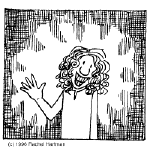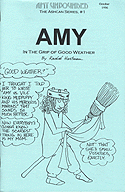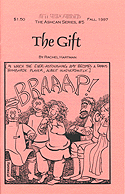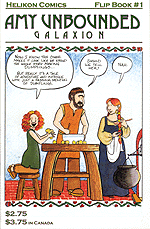Rachel Hartman Chats With SBC
Posted: Tuesday, April 25, 2000
By: Darren

One of the other staff members for Silver Bullet Comics mentioned Amy Unbounded to me on our discussion list. He said it's really good and that the characterization is the best he has ever seen in a comic. Then the staff member posted a interesting article from Rachel to our small press news page. I figured a chat with her was a must.
Darren Schroeder: What is your full name?
Rachel Hartman: Rachel Mae Hartman
DS: Age?
RH: Pushin' 28
DS: Favourite web site?
RH: http://www.sequentialtart.com -- a fun, informative comics e-zine, run almost entirely by women and updated monthly. I particularly like their feature "Bizarre Breasts," which gives a monthly anatomy lesson to various artists who can't seem to grasp the concept that breasts aren't balloons.
DS: Were comics a big part of your childhood or did you discover them at a later stage?
RH: I didn't read comic books as a child, but I was a great fan of newspaper comic strips, particularly Calvin and Hobbes, The Far Side, Doonesbury, Pogo (which wasn't in the papers, but my mom had some old collections) and Peanuts. My old room at my parents' house still has Snoopy wallpaper, in fact, and I had all the Peanuts collections. Animated cartoons were also fairly prevalent, especially Looney Tunes and the standard Disney fare. But I didn't start reading actual comic books until after I started doing one myself, so even now there's lots of basic stuff -- the whole superhero genre, for example -- that I've never even read.
DS: Was art an important part of your education? RH: I never had any formal training. My mother is a painter and was an art teacher before that, so I have no doubt I picked up a lot growing up. But I never took any real classes, not even in high school. I can't decide if I regret that or not. I was always into writing, so I think that part of my comic has been strong enough to give the artwork time to catch up.
RH: I never had any formal training. My mother is a painter and was an art teacher before that, so I have no doubt I picked up a lot growing up. But I never took any real classes, not even in high school. I can't decide if I regret that or not. I was always into writing, so I think that part of my comic has been strong enough to give the artwork time to catch up.
DS: Was Amy Unbounded the first comic you published yourself?
RH: Yes. Previously I had done a comic strip called Ellen of Troy for the school paper in college, and I did three children's books about tree care for the International Society of Arboriculture. I then tried my hand at a graphic novel, of all things, but decided I needed to get my artwork a bit more polished before I could do my ideas justice. So Amy Unbounded started out as a little project I could do while I got better at drawing, but has ended up being an end in itself.
DS: Describe for us the setting of Amy Unbound.
RH: Amy Unbounded takes place in a fictional medieval country called Goredd. People have tried to second guess me as to what country it's supposed to represent -- Wales is the most common guess, I think because of the double d in Goredd -- but it really and truly is not intended to parallel any one country. I am something of an amateur medievalist, so there's a lot of mixing and matching going on. If a detail in costume or architecture intrigues me, I include it, and I try to create other details that are uniquely Goreddi. Even cultural details, such as superstitions and hand gestures, can contribute to the depth and richness of place.
The story takes place in the country, for the most part, with occasional trips to town. I really enjoy drawing the countryside, whose trees and rolling hills were inspired by my native Kentucky. Amy's family lives on a small sheep farm called Eddybrook. One goal of mine, as the series progresses, is to get better about including more animals in my drawings. Medieval people lived in very close company with their animals, and I don't think I've reflected this.
DS: How do you distribute your comics now?
RH: Mostly it's just me going around to comic conventions, but my book is also carried by FM International (which distributes to retailers). I also sell the book directly to retailers and Internet retailers and do a good amount of mail-order business from my website
DS: What materials and equipment do you use when drawing your comics?
RH: I draw the comic 25% larger than the final version on plain old 2-ply Bristol, doesn't matter what brand, plate surface, acid free. I use a brush, mostly, but use Hunt 102 nibs for crosshatching and finer work. Ink has been mostly Higgins Black Magic, although I got some "FW Acrylic Artists Ink" from my mother-in-law for Christmas which I've been trying out lately. It's excellent on the brush, but a nightmare on the nibs because it dries too fast or something. I have several different brushes of varying qualities, but my favorite by far is the first one I ever bought, an el-cheapo no-name brush from a Michael's craft store. I've rubbed the name off it over the years, I'm afraid, so I can't even tell you what it is, but it's never lost a hair and is still going strong.
DS: Who do you see as the target audience for your work? RH: Well, I was originally aiming for 9-13 year old girls, but I've found that a wide spectrum of people like my work. I think my audience is really anybody who enjoys a good story and has a similar sense of humor to me.
RH: Well, I was originally aiming for 9-13 year old girls, but I've found that a wide spectrum of people like my work. I think my audience is really anybody who enjoys a good story and has a similar sense of humor to me.
DS: What work have you been doing recently?
RH: I am doing a multi-issue Amy Unbounded story, and am currently working on part 5 of 6. It's sort of a coming of age story about the summer Amy and her friend Bran turn ten. They're beginning to really take notice of what's happening to the adults around them, and there's a lot happening: Amy's father gets kicked out of the guild, her mother's best friend is going to lose her business if she doesn't get married quickly, Bran's sister has unwittingly fallen in love with someone completely inappropriate, and Bran's boorish older brother is planning to marry and make their sister a servant in her own home. It's a rough time for both kids, and it remains to be seen how well they'll navigate through it.
DS: An issue that seems to come up alot in relation to children's literature is what topics such work should deal with. Issues of abuse, drugs and sexuality are things that effect children/young adults but a lot of people don't think children's literature should reflect them. How do you view this question in relation to your own work?
RH: It's a difficult question. I think children can see right through writing that's too homogenized and bland, and I think it bores them (as well it should). There is a lot in life that is frightening and bewildering, and I think a thoughtful attempt to deal with such questions will ultimately be useful to a child. That being said, you're probably not going to find many of the issues you mentioned in my comic, primarily because they don't particularly interest me. I have my own set of nontraditional subjects -- economics, atheism, and gender issues, to name a few -- which are probably not considered suitable for children, but which I think children will benefit from exposure to. Ultimately, I think one should worry less about self-censorship and pleasing people and more about producing honest, well thought-out work.
DS: When you say you have nontraditional subjects that you think children will benefit from exposure to, don't you run the risk that these interests might "take over" the comic?
RH: Yes indeed. That's one of the big challenges: how to give the work depth without coming right out and bopping everyone on the head with it. I am a definite believer in the virtues of subtlety. If I wanted to foist my opinions onto people, I would have become an essayist, not a cartoonist. At the same time, I want to do work that interests me, and so my preoccupations are going to travel with me wherever I go. The subject of economics, for example, particularly Medieval economic history, is endlessly fascinating to me, but I realize just the word "economics" is enough to put some people to sleep. So I have to contextualize it, show economic forces at work in the lives of Amy and her parents. The characters are interesting enough that economics just becomes soemthing that happens to them.
DS: What would make you dislike a comic?
RH: I admit to judging books by their covers -- if the cover is uninviting, (and for me that includes gore, women with improbably huge breasts, anything that strikes me as unnecessarily grotesque) I'm probably not even going to pick up the book and leaf through it. Other than that, it's the writing that really makes the difference for me. I'm willing to forgive a lot in the artwork if there's a story going that really fascinates me.
DS: If a film was made of your life, who should play you?
RH: Janeane Garofalo. She's a little short, but when I think over my life I have to ask, what's really been important? Being my height, or being an outspoken smartass? Smartass wins it, every time.
DS: What can the comic medium do that the other media cannot? RH: I like the way you can have multiple narratives going on at the same time in comics. The characters can be talking about one thing while doing something completely different (which makes up a visual narrative) and while having first person commentary by a narrator of some sort on top of that. I like the visual component particularly, in that it allows me to include background details that would simply be tedious as prose description.
RH: I like the way you can have multiple narratives going on at the same time in comics. The characters can be talking about one thing while doing something completely different (which makes up a visual narrative) and while having first person commentary by a narrator of some sort on top of that. I like the visual component particularly, in that it allows me to include background details that would simply be tedious as prose description.
DS: Do you enjoy going to comic conventions?
RH: I really do. They made me nervous at first, because the prospect of having to maintain a cheerful aspect and converse with complete strangers seemed quite daunting. But now I really look forward to them, largely because I've made a lot of cartoonist friends. We hang out after hours, sketching and laughing, and it's great. I think a lot of us, myself included, were considered geeks in school and didn't have a lot of friends, but now we have this community, albeit for three or four weekends a year, and it's very gratifying.
DS: Do you get much fan mail? What do the fans seem to like about your work?
RH: I get a fair amount. Fans seem attracted to the humor, the characters and the writing. What surprises me most, actually, is not the fan mail but the gifts -- I've gotten books, chocolates, gift certificates, pictures of ferrets... it's very flattering but just a touch weird.
DS: How would you feel about someone else writing for your characters?
RH: Heh heh heh. It would be fascinating and terrifying. I'm sure it would be quite a revelation to me to see how my characters come across to other people, and maybe it would give me insight into the characters that I wouldn't have had otherwise. But I'm enough of a control freak that it would be hard to just sit back and let someone else take the wheel.
DS: Is Amy Unbounded earning it's keep financially?
RH: I break even almost exactly, including travel expenses to conventions, so as far as that goes, I can't complain. I'd love to be able to make a living of it someday, but I think for now I'm happy just not being hugely in debt.
DS: If a person from Disney knocked on your door with a blank cheque and wanted to buy Amy Unbounded from you, how would you react?
RH: It's very hard to say. I imagine, realistically, that there's a price at which I can be bought, a point beyond which my practical brain will remind me that financial independence means I can work full time on other projects and not be tied down by a part-time job. BUT, and that's a very big but, there is so much of myself tied up in this comic that I can't begin to imagine selling it. It'd be like someone asking me for my arm. Sure I could sell it, but it'd leave a mighty big hole.
DS: What's the best bumper sticker you have ever seen?
RH: Study Naked. That became my motto in college.
On that nude note we finish. A big thanks to Rachel for taking time to swap e-mail with us.
You can contact Rachel at:
5464 S. Harper #2D
Chicago, IL 60615, USA
Related Links:
Comics Worth Reading: Amy Unbounded reviews (Thanks for the scans Johanna).
The Amy Unbound Homepage (Thanks for the scans Rebecca).
Rachel's Homepage
Sequential Tart have a chat with Rachel.
If you have a comment or question about Small Press then feel free to contact me